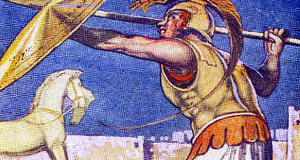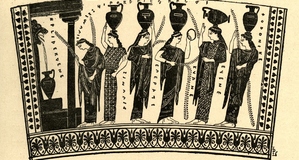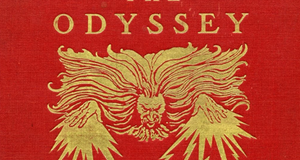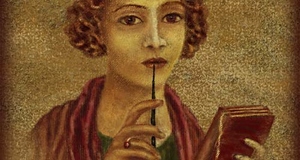Penelope, Helen, and the Ancient Greek Spectrum of Femininity: Observations of Womanhood in the Homeric Epics
By
2021, Vol. 13 No. 02 | pg. 1/1 AbstractAlthough most Ancient Greek literature focused on male characters, a literary analysis of Homeric poetry reveals an inquisition of femininity, motherhood, and what it meant to be a woman in Ancient Greece. Throughout the epic The Iliad and its sequel The Odyssey, the Homeric poets created a spectrum of ideal versus unideal femininity, with notorious Helen on one end and faithful Penelope on the other. Dissection of each epic unveils an exploration into this spectrum of femininity through the use of motifs, or the repetition of a theme throughout a narrative. Specifically, the poets utilized the motifs of storytelling and weaving -- two fundamental elements of Ancient Greek womanhood -- to portray the ways in which both of the heroines embodied femininity. Through these characters and motifs, the Homeric epics contain hidden yet profound representations of womanhood in Ancient Greece. It is no surprise that the Homeric epics focused almost entirely on the woes and triumphs of men. Literature tends to reflect the values of the era in which it was written, and the Ancient Greek poems are no exception -- throughout the works, the Greek values of honor, glory, respect for the gods, and male dominance permeate the pages. However, the two female characters Helen and Penelope stand out against this male backdrop. Despite their lack of spotlight, the epics could not have existed without them -- it is Helen “for whose sake, by the will of the gods / the Greeks and Trojans suffered through the [Trojan] War”[1], and it is Penelope who “[kept] her husband’s house safe till he [returned]”[2]. Through these characters, the Homeric poets demonstrated the Ancient Greek spectrum of femininity, with “ideal” on one end and “unideal” on the other. Specifically, through the motifs of storytelling and weaving, the epics illustrated ideal femininity through Penelope and unideal femininity through Helen. To appreciate the ways in which the actions of the two women embody ideal or unideal femininity through these literary devices, one must first construct an understanding of femininity in Ancient Greece. To build this knowledge, one can imagine a spectrum, or a straight line with a pole on each end. In the center of this spectrum rests basic femininity, the obligatory standards to which the Ancient Greek society expected women to conform. This level includes beauty, weaving at the loom, and subservience -- including sexual submission -- as demonstrated within the first book of the Iliad, in which the Greek warrior Agamemnon discusses his capture of Chryseis, his “prize,”3 detailing that he wishes for her to “[go] up and down by the loom and [be] in bed as my companion”4. Moving outwards, on one end of the spectrum lies ideal femininity, encompassing the elements of basic femininity but also wisdom, marital loyalty, and raising children. On the contrary, unideal femininity -- comprised of disloyalty and the feminal practice of agency in a patriarchal society -- sits on the other end. An example of unideal femininity can be seen when the goddess Circe transformed Odysseus’ men into pigs, exercising her agency while stripping the men of theirs5. To emphasize the basic difference between the two poles on this spectrum, one must understand that ideal femininity is supportive of male dominance, while unideal femininity disrupts it.The Homeric poets utilized the motifs of storytelling and the loom to represent ideal versus unideal femininity. Primarily, Helen used the art of storytelling to practice agency and defy the male narrative in the Odyssey. While residing in the company of men in her court, Helen desired to tell a story, but she realized that delivering a speech amongst the men would be socially unacceptable; thus, she opted to “mix the wine with drugs” so that the men would allow her to speak6. While this act alone demonstrates Helen’s refusal to accept the constraints imposed on her by the patriarchal society, the story she tells also disrupts male dominance by opposing the narrative. She reveals that not only did she alone recognize Odysseus when he entered Troy, but also that she “‘washed and scrubbed him with oil and dressed him,’”7 a detail with sexual connotations. Additionally, she also blamed the goddess Aphrodite for making her “‘go crazy,’” pushing her to pursue Paris, thereby trying to shed any blame for her actions8. By telling this story in the presence of men -- including her husband, King Menelaus -- Helen practiced agency, even going as far as revealing a detail that could be implicative of marital infidelity, which disrupted the dominance of men, as well as the dominance of her husband over her. However, notably, Menelaus followed her story with one of his own, implying that Helen may not have been as loyal to the Achaeans as she was to the opposing Trojans. “‘Some spirit who desired to glorify the Trojans urged you on,’”9 he said, suggesting that she was disloyal not only to the Achaeans, but also to him. While he prefaced this story by agreeing with Helen, the story he told presented a different picture of her. Thus, through the motif of storytelling, one can see Helen disrupting male dominance, but also being oppressed by it. Penelope, in contrast, utilized storytelling to build upon male dominance. Stories she told were mixed with references to Odysseus, laced with her yearning for him, and spiked with her loyalty to him. For example, after one of her suitors inundated her with compliments, Penelope “replied with caution,”10 seizing the opportunity to tell the suitors about the moments she enjoyed with her husband he left to fight in the Trojan War. She remarked that the gods “‘destroyed [her] looks that day the Greeks embarked for Troy’” and that Odysseus returning home was the only way she could reclaim her “‘good name” and “beauty,’” ending her story by lamenting the lack of bridal gifts the suitors had given her11. In telling this story, Penelope attributed her beauty and her status to her husband, cursed the gods for allowing misery to come upon her, and solicited gifts from the suitors, exemplifying her desire to contribute to the dominance of her husband and her attempt to grow his wealth, while also emphasizing her loyalty to him. Indeed, as he listened to her speak, the disguised Odysseus “was happy she was secretly procuring presents, and charming them with pretty words”12. Her story allowed her to build upon the legacy and reign of her husband, which contributed to male dominance. Another instance in which Penelope intertwined her storytelling ability with her cleverness appeared when she told the disguised Odysseus about her ominous dream. With calculation and care, she divulged to him that she had seen “‘a huge eagle with a pointed beak’” killing “‘twenty geese’” as she slept, revealing that the eagle then spoke to her “‘in human language’” and told her that it was actually her husband returning in the form of an eagle “‘to put a cruel end to [the suitors represented by the geese]’”13. In response, the hero in the disguise of a beggar comforted her by agreeing that her dream meant “‘ruin for the suitors’” at the hands of “‘Odysseus himself’”14. While the epic did not disclose beforehand whether or not she had deciphered that the beggar to whom she spoke was her husband in disguise, it is clear that Penelope told him this dream to imply that she longed for the expulsion of the suitors, as well as the return of her husband. Thus, by combining storytelling and cleverness to discuss her loyalty and subservience to her husband, Penelope embodied ideal femininity; meanwhile, by using storytelling to gain agency in the patriarchal society, Helen displayed unideal femininity. Weaving at the loom constituted the second motif the Homeric epics used to illustrate the spectrum of femininity. While weaving was an element of basic femininity to which women were expected to comply, both Helen and Penelope exhibited their personalities and femininities through their weaving -- Helen’s work at the loom was an extension of her desire to practice agency, while Penelope’s work was an extension of her loyalty to her husband. In the Iliad, Helen was found “weaving a great web,” incorporating within it the “struggles that the [Trojans and Achaeans] endured for her sake at the hands of the war god”15. Within the threads she weaved, Helen practiced agency by telling her own version of events in this specifically feminine medium. Although the exact details of the “red folding robe”16 she stitched remain unclear, the essence can be extracted from her conversation with her father-in-law, King Priam, a few lines later. As she described the Achaean men to Priam and his court, Helen referred to herself as a “helper in war,”17 and implied that she herself desired to “follow [Priam’s] son”18. Through these brief sentences, Helen practiced agency by refusing to downplay her role in the cause of the Trojan War and attempting to tell her version of the events, aspects that likely comprised the design of the robe she weaved. In her weaving at the loom, Helen rejected the male narrative and composed her own, defying male dominance and practicing agency. On the other hand, Penelope utilized weaving at the loom to further demonstrate her loyalty to her husband. As the weary queen revealed to the disguised Odysseus, she told her suitors that she would marry one of them once she completed weaving a funeral shroud for Laertes, Odysseus’ father19. However, her promise was intertwined with deception -- “‘by day I wove the web / and in the night by torchlight, I unwove it,’” she unveiled to him20. Thus, through weaving and cleverness, Penelope remained loyal to her husband and protected his kingdom for as long as she could before the suitors caught on and forced her to finish the shroud. Additionally, as Odysseus described in his response, Penelope had woven her husband a “‘purple cloak, of double-folded wool / held fastened by a golden brooch’”21, articles with complexity and texture that “‘astonished many women’”22. While she wove the funeral shroud out of cleverness and the clothing out of love, both articles demonstrate the support Penelope maintained for her husband and his dominance, as well as her desire to protect his kingdom while he was away. In summary, the Homeric epics The Iliad and The Odyssey utilized the motifs of storytelling and the loom to demonstrate the ideal and unideal poles on the Ancient Greek spectrum of femininity. In the same way women of the era were defined by the men surrounding them, ideal and unideal femininity were defined by their relationships to male dominance. Helen’s storytelling and weaving exhibited her desire to gain agency and reject the narrative forced upon her, therefore disrupting male dominance; meanwhile, Penelope’s storytelling and weaving exemplified her loyalty to her husband, supporting male dominance. However, Helen and Penelope were not foils of one another, nor did they themselves represent the poles of femininity -- merely their actions did. While “wise” and “prudent”23 Penelope embodied ideal femininity almost exclusively, “lovely haired”24 yet “accursed”25 Helen exhibited aspects of both ideal and unideal femininity. The construction of each character signifies the complexity the Homeric poets desired each one to have, despite their statuses in the Ancient Greek world as inferior to men. Although female characters rarely received the spotlight in either epic, the subtle ways in which the poets revealed their contributions to the plotlines signified that there would simply be no epics without the actions of women. ReferencesHomer. 2011. The Iliad. Translated by Richard Lattimore. Chicago: University of Chicago Press. Homer. 2007. The Odyssey. Translated by Richard Lattimore. New York: Harper Collins Publishers. Endnotes1.) Homer, Od. 17.120 2.) Homer, Od. 23.151 3.) Homer, Il. 1.120 4.) Homer, Il. 1.30-31 5.) Homer, Od. 10.240 6.) Homer, Od. 4.220 7.) Homer, Od. 4.249-253 8.) Homer, Od. 4.261 9.) Homer, Od. 4.273 10.) Homer, Od. 18.249 11.) Homer, Od. 18.252-281 12.) Homer, Od. 18.282 13.) Homer, Od. 19.540-550 14.) Homer, Od. 19.560 15.) Homer, Il. 3.125-128 16.) Homer, Il. 3.126 17.) Homer, Il. 3.188 18.) Homer, Il. 3.174 19.) Homer, Od. 19.144-145 20.) Homer, Od. 19.148-149 21.) Homer, Od. 19.225-226 22.) Homer, Od. 19.233 23.) Homer, Od. 18.243 24.) Homer, Il. 11.505 25.) Homer, Il. 19.325 Suggested Reading from Inquiries Journal
Inquiries Journal provides undergraduate and graduate students around the world a platform for the wide dissemination of academic work over a range of core disciplines. Representing the work of students from hundreds of institutions around the globe, Inquiries Journal's large database of academic articles is completely free. Learn more | Blog | Submit Latest in Literature |


















